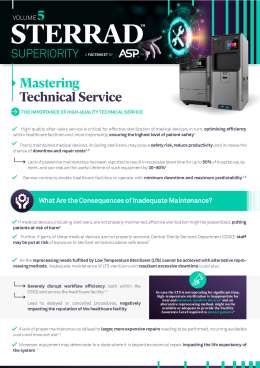Increased Costs
Insufficient maintenance can reduce the lifetime of sterilizers and increase the need for larger, more expensive repairs, resulting in increased cost and resource use.2, 4
Whilst maintenance of medical devices and sterilizers by a non-authorised third party may provide a perception of proper maintenance, the potential lack of expertise means that such technical support poses similar risks to a complete lack of maintenance, as well as causing additional problems, such as the voiding of a system’s warranty.1
The ASP™ Technical Service Value Proposition provides a high-quality solution to sterilizer maintenance and servicing, offering industry expertise and a rigorous maintenance process whilst causing minimal disruption to productivity.1 This maintenance is critical to ensuring effective and efficient sterilization, which in turn helps to promote patient safety and mitigate the risk of health-care associated infections.1, 5, 6
References
Advanced Sterilization Products. STERRAD™ Superiority Factsheet Volume 5 - Mastering Technical Service. AD-210077-01.
World Health Organisation. Medical equipment maintenance programme overview. 1986.
Advanced Sterilization Products. STERRAD™ 100NX System with ALLClear™ Technology User Guide. A11150401-50.
World Health Organisation. How to Organize a System of Healthcare Technology Management Guide. 2005
Rutala WA, Gergen MF, Sickbert-Bennett EE, et al. Comparative evaluation of the microbicidal activity of low-temperature sterilization technologies to steam sterilization. Infect Control Hosp Epidemiol 2020;41:391-395.
Centers for Disease Control and Prevention. Guideline for Disinfection and Sterilization in Healthcare Facilities. Low-Temperature Sterilization Technologies. 2008.

